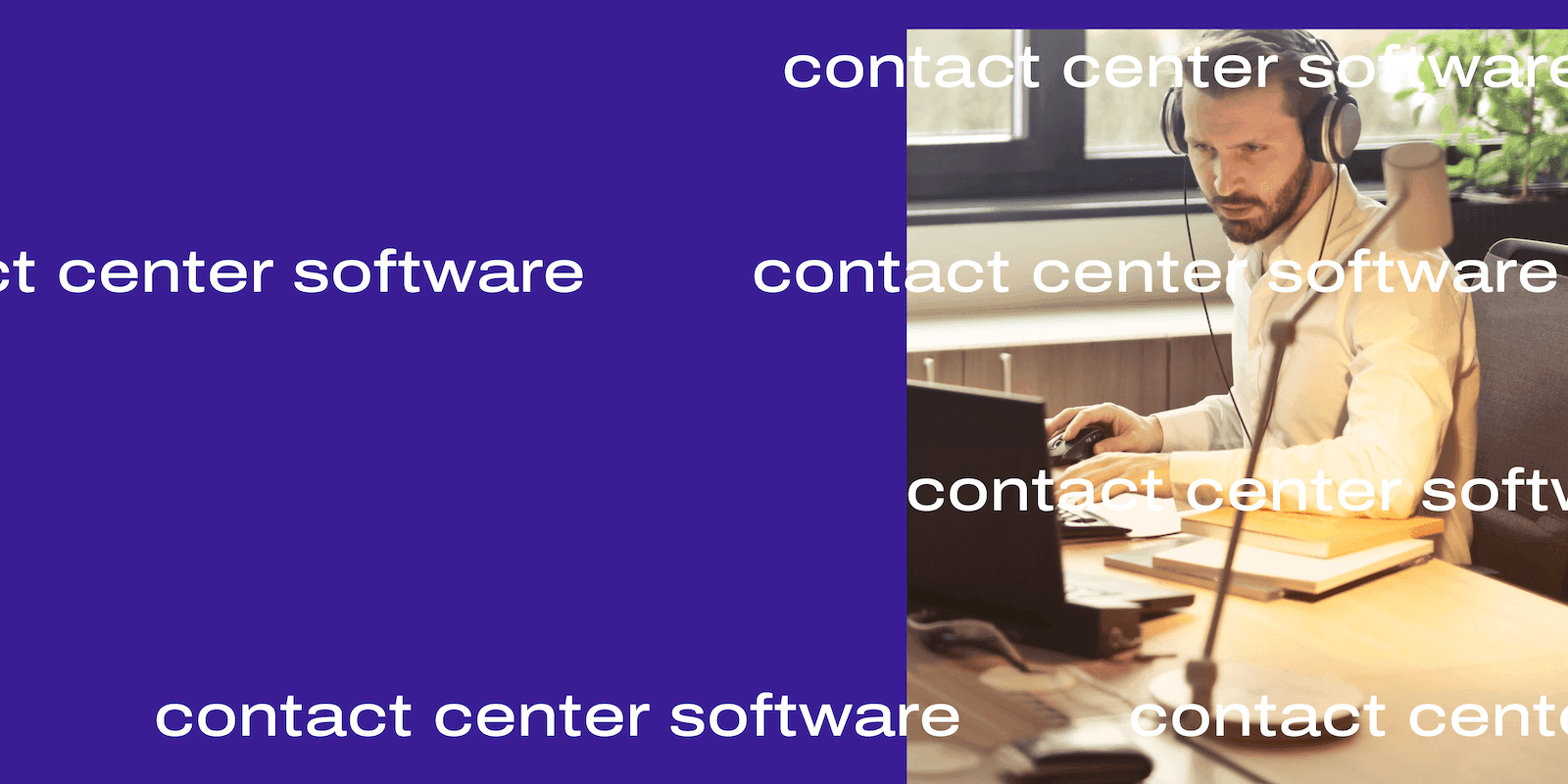
Tags
Share
Choosing the right contact center software can be overwhelming and there’s no shortage of blog posts out there listing all the “top contact center software,” but in our case, we’re going to focus on one primary factor: ease of use.
A solution that’s easy to set up, manage, and use means faster adoption, better agent productivity, and ultimately, happier customers. And with Ai transforming contact centers, advanced Ai capabilities should also be a key consideration, so that will be a secondary consideration for how we ranked the list below.
These are tricky to evaluate for, partially because it's not always easy to check what every task in your daily workflow might look like in a contact center solution. Also, there are always those little buggy inconveniences that seem like they're not a big deal in a demo—but when you have to do them regularly, those little inconveniences end up being big productivity-killers.
(For example: Adding agents and removing agents, or adding or managing phone numbers for new hires.)
So, which platforms truly deliver on ease of use and Ai? We evaluated the top contact center solutions based on these criteria without wading through generic feature lists. As an overview, here are the top three contact center software options—and yes, we may be a bit biased, but only in part because Dialpad’s artificial intelligence technology really is among the most advanced (hit the links to check out each in more detail below):
Dialpad Support
Five9
Aircall
And here’s a quick breakdown of how they stack up against each other:
Dialpad Support vs. Five9 vs. Aircall
Instead of just listing out all the features for every contact center software, here’s a side-by-side comparison of three of the strongest solutions.
If you want a contact center platform that’s easy to use, with built-in proprietary Ai and omnichannel communications, Dialpad Support is the most cost-effective choice.
Dialpad Support | Five9 | Aircall | |
Ease of setup | Set up in hours | ? | ? |
Ai transcription and summaries | ✅ | ✅ | ✅ |
Proprietary LLM | ✅ - DialpadGPT | ❌ | ❌ |
Training dataset | 8 billion minutes of business conversation data | ? | ? |
Price per agent, per month | Starting at $80 | Starting at $1191 | Starting at $302 |
Built-in UCaaS features | ✅ | No; available through integrations with other providers | No video meetings or team messaging |
What is contact center software?
Contact center software is a type of software that lets businesses handle a large volume of phone calls and messages using a computer or mobile device. Usually, these are sales and support conversations with customers and prospects. Besides facilitating customer communication, these solutions will often come with other features, like the ability to record calls and forward calls, conversation analytics, and live coaching features.
Types of contact center software: On-premises and cloud-based
There are two main types of contact center software: on-premises and cloud-based (also known as CCaaS, or Contact Center as a Service). On-premises solutions require physical hardware, dedicated IT teams, and significant upfront costs, making them less flexible—especially for remote teams or businesses looking to scale.
Cloud-based solutions, on the other hand, offer subscription-based pricing with no hardware requirements. They’re easier to set up, maintain, and update since the provider handles everything, making them a more cost-effective and scalable choice for most businesses.
👉 What customers think:
"With Dialpad, we can set up a new call center in 10 minutes from anywhere. We have the flexibility to manage our call center on our own, and it's easy.” — Mike Monteiro, Communications System Manager at EF Education First
The 12 best contact center software solutions: Ranked by ease of use
1. Dialpad Support
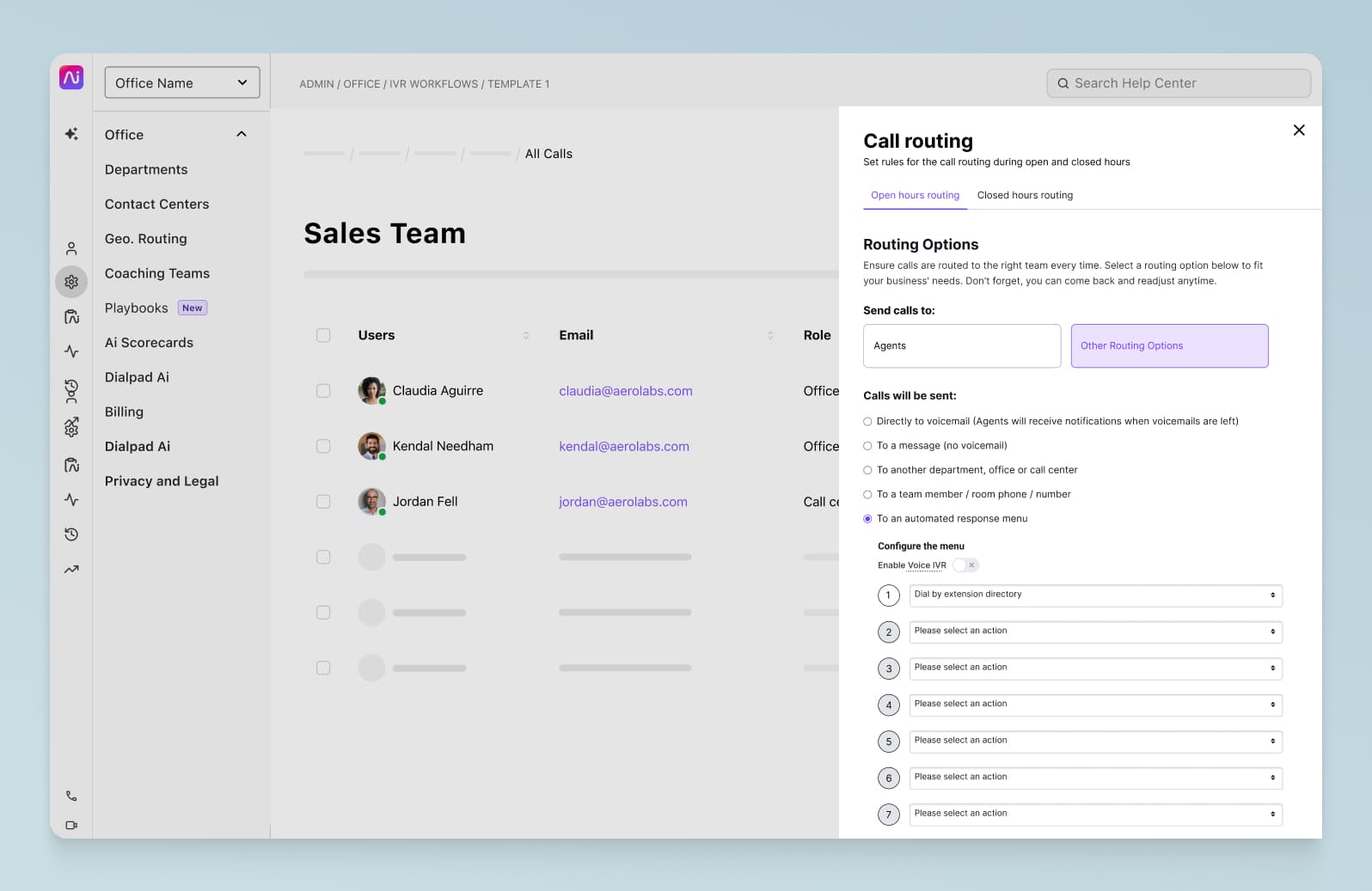
Dialpad Support stands out for its intuitive design, ease of use, and advanced Ai-powered features, making it a top choice for both customer service and sales teams. Setup is fast—you can add new agents and phone numbers right from your online dashboard. It takes literally just a few clicks and a few minutes of your time:
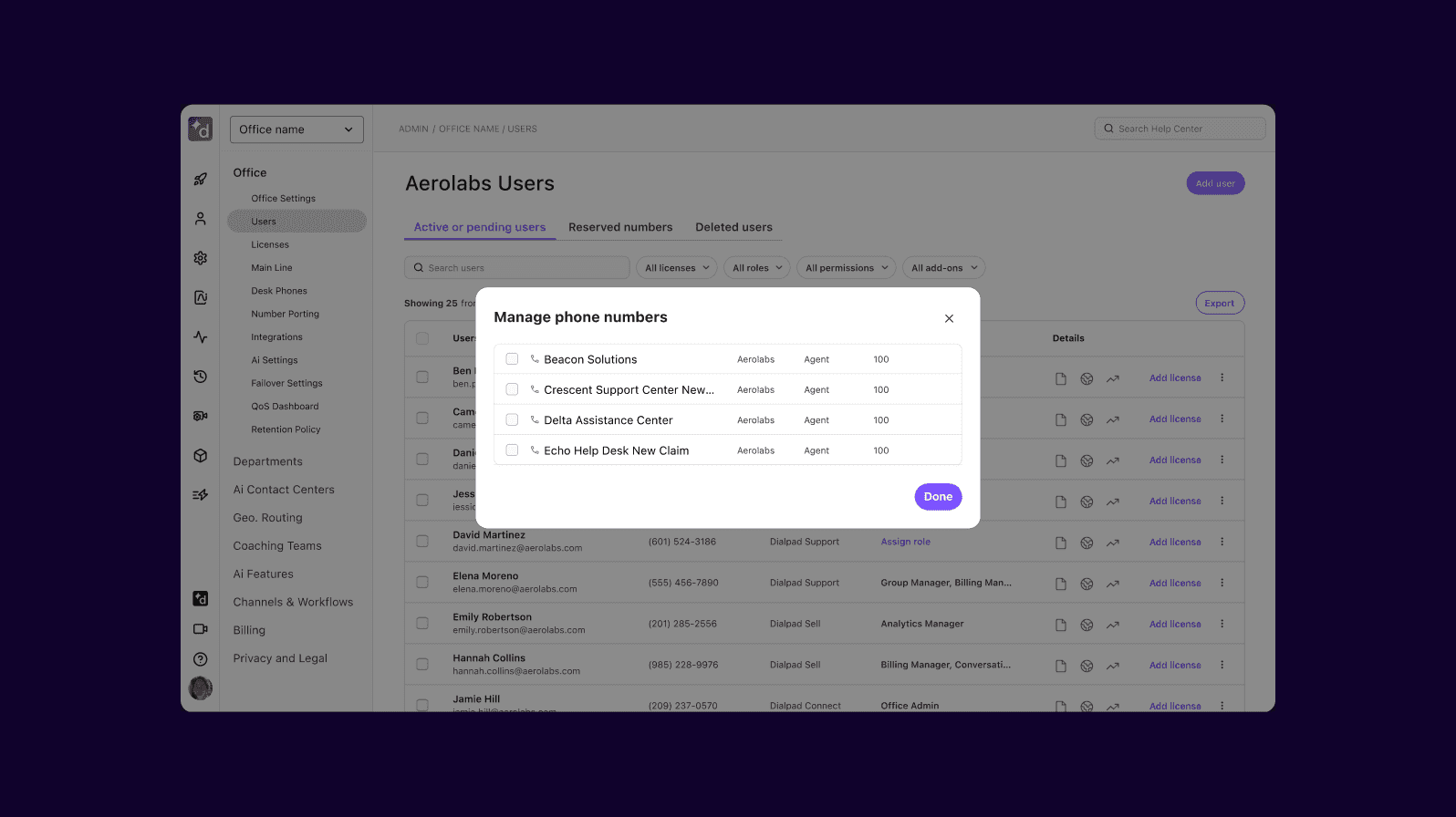
Agents can work seamlessly across desktop and mobile apps (iOS, Android, PC, Mac). Plus, 24/7 customer support is available even on the least expensive plan, something rare among competitors.
But really, those are just table stakes. Those things should be simple to do in your contact center software. What really sets Dialpad apart are the things you don't expect. Like its artificial intelligence.
Industry-leading Ai
What truly sets Dialpad apart is Dialpad Ai, its proprietary Ai technology that transcribes calls and voicemails in real time:
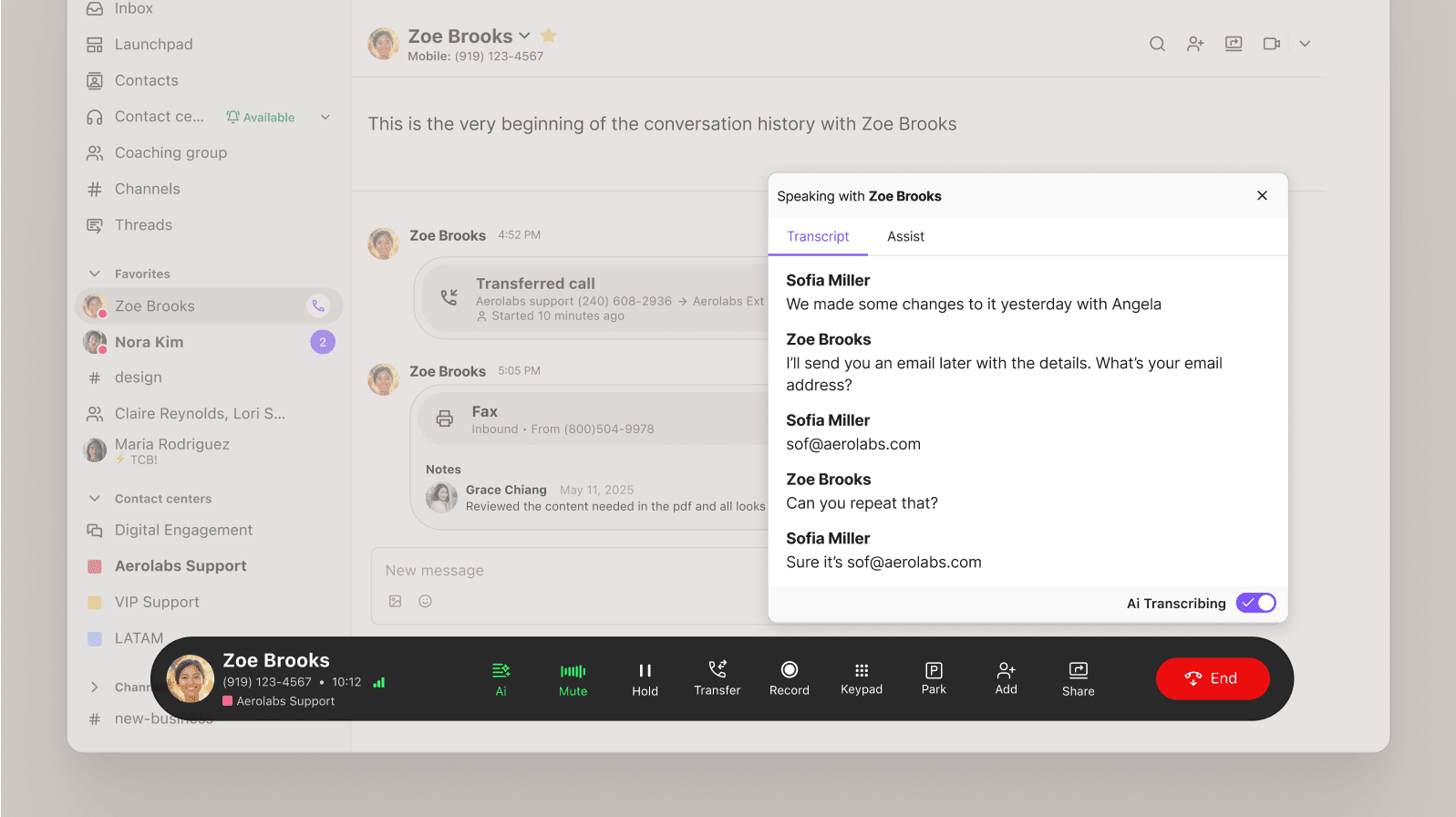
But it goes beyond transcription.
Keyword tracking: Track mentions of competitors, product issues, or other key terms to gain conversational insights. You can create “Custom Moments” to track these keywords and phrases:
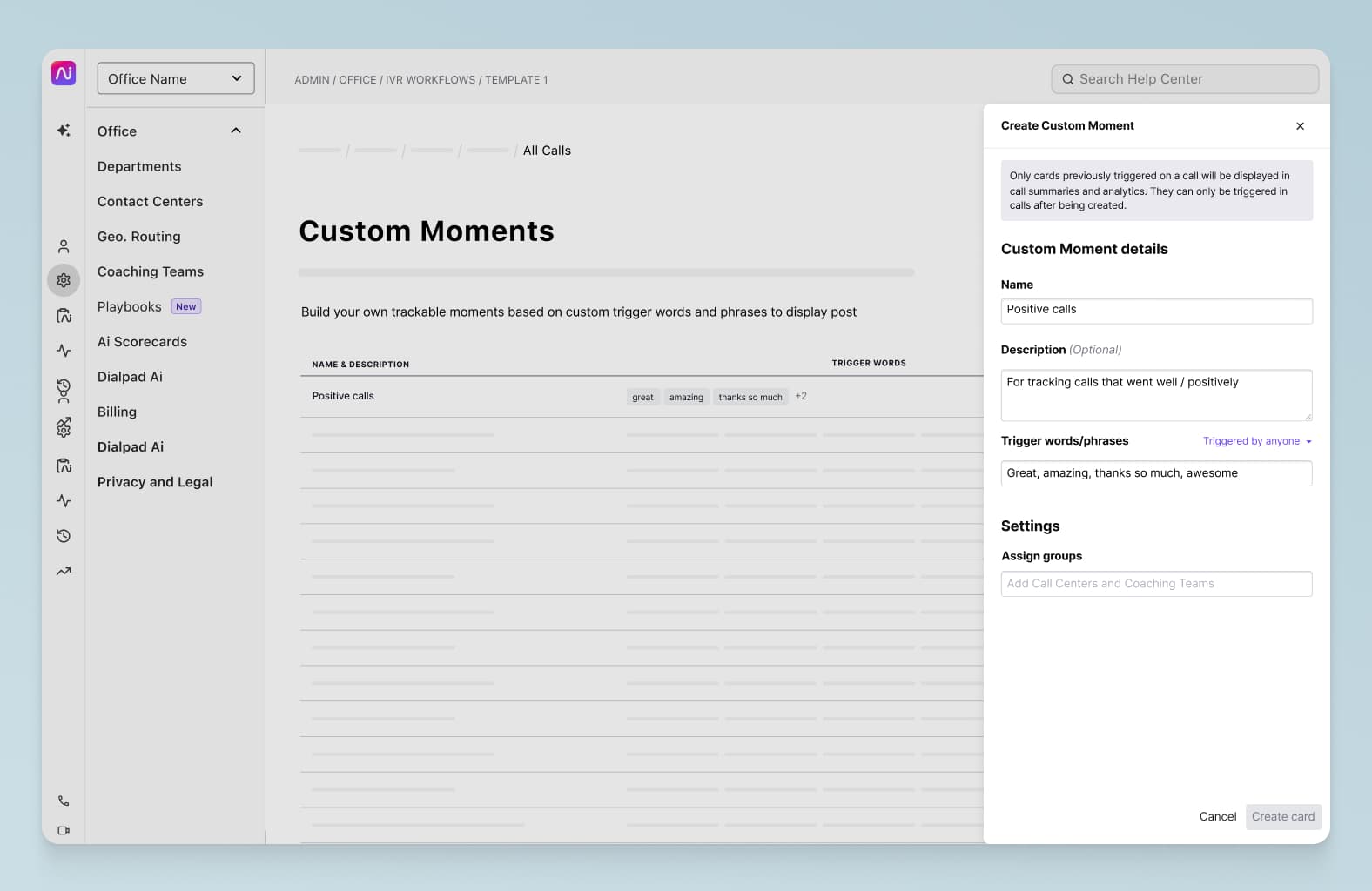
Real-time agent assists: Dialpad Ai delivers real-time coaching—automatically surfacing relevant notes on an agent’s screen when certain keywords are spoken. It’s like automated coaching at scale:

Truly unified communications channels
Unlike almost every contact center platform that requires separate tools for different channels, Dialpad integrates VoIP calls, SMS/MMS, video conferencing, and team messaging into one platform.
And then there are the little things too. For example, a big time-saver for outbound call center teams is the voicemail drop feature, which lets sales reps record a voicemail message and “drop” it into a call if the prospect doesn't pick up:
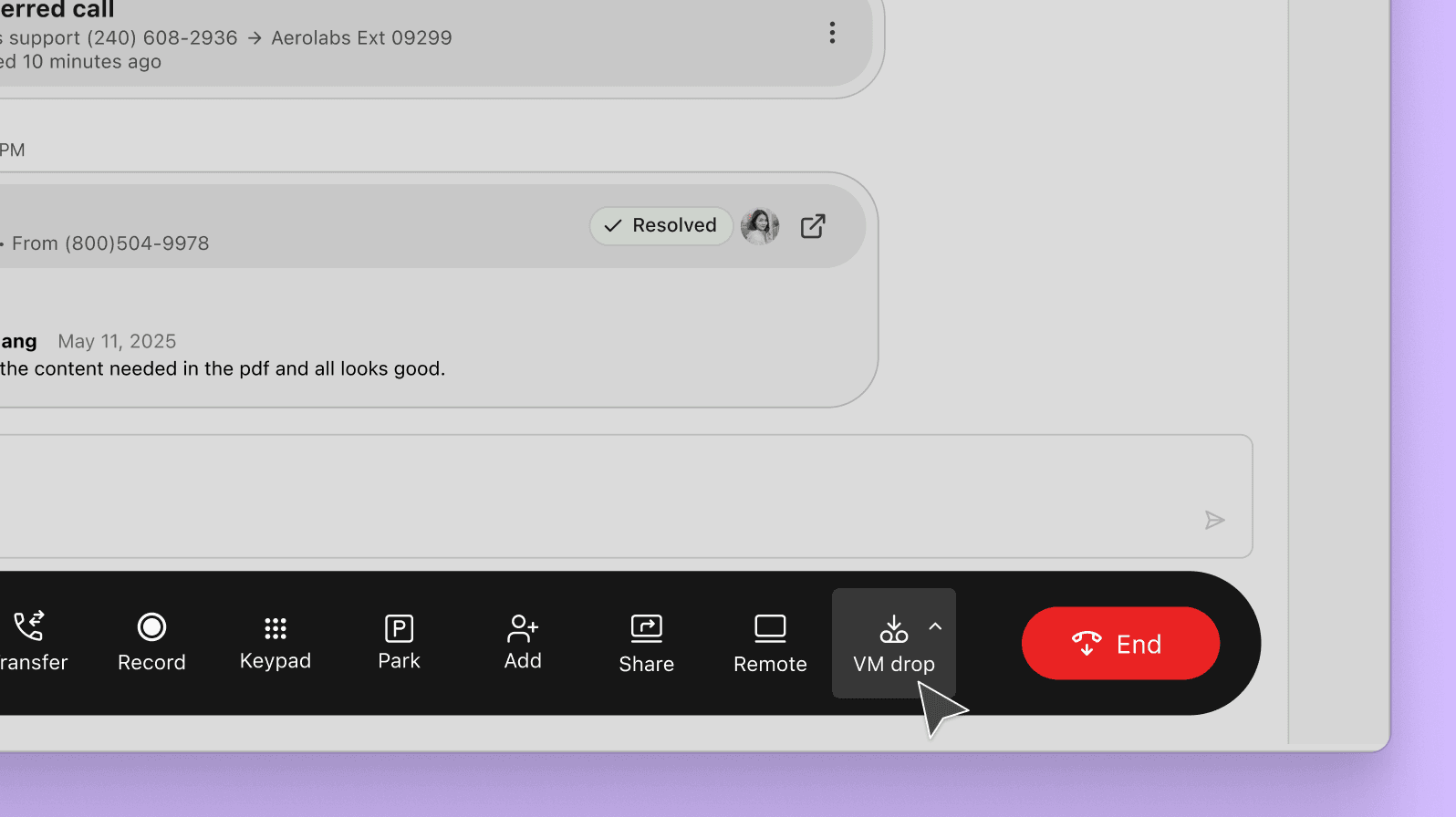
For high-volume cold calling teams, this can add up to hours saved every week.
Why both small businesses and enterprises love Dialpad Support
For small businesses (we're talking less than 50 agents) Dialpad is incredibly easy to use, and it's important to note that this size of business has historically been priced out of contact center software. Dialpad is affordable and flexible enough that it makes sense as an investment for small business call centers.
Dialpad also integrates with a huge variety of business apps. For example, there are CRM integrations like the ones with Salesforce and HubSpot, which automatically log activities and embed Dialpad’s dialer to let agents make phone calls directly from the CRM:

Want to build your own custom contact center integrations? You can do that too with the API.
👉 What customers think:
“One thing that I love in Dialpad is the call journey feature, where you can see where calls were routed, forwarded, and changed. It's beautiful, and brought a lot of peace of mind to our call center operations—there's no more wondering where a call came from or how someone got it.” - Sahil Farooqi, Head of Customer Care, Rently
Interested in an integrated cloud contact center solution?
Dialpad's contact center platform gives you VoIP calls, video conferencing, SMS/MMS messaging, instant messaging—and contact center features—in one platform.
See how Dialpad Support works
Check it out, dig into the unique Ai-powered features, and learn more about pricing info. Book a demo, or take a self-guided interactive tour of the app on your own first!
2. Five9
Perhaps best known in recent years for its almost-acquisition by Zoom, Five9 is a contact center solution that has the fundamentals that you'd expect like CRM integrations and workforce optimization tools.
While Five9 is a cloud solution, there isn’t much information on how easy it is to set up, say, a new agent or phone number. But what they do have is a strong selection of Ai features, similar to Dialpad Support—such as Ai-powered transcription and summaries, agent assists, and conversational insights. The downside is that these appear to be add-ons for an extra charge1, whereas even Dialpad Support’s base plan comes with Ai transcription and keyword tracking.
A few of the features you get:
Outbound and inbound calling
IVAs (intelligent virtual agents)
Ai transcriptions and summaries
Ai chatbots
Pricing: Their base plan starts at $119 per user per month, and it looks like a number of features (agent assist and CRM integrations) are priced separately as add-ons.1
🤿 Deep dive:
Get an in-depth look at Five9 vs Dialpad Support!
3. Aircall
Aircall is another cloud-based phone system and outbound / inbound call center software. It's not quite an omnichannel or multichannel contact center—although it does include business SMS.
Because it’s designed for small and medium-sized businesses, it's considered to be pretty easy to use, which is why it’s high up on this list, but missing some features that more established brands such as Dialpad Support and Five9 have. Another trade-off is if you’re looking for UCaaS features, it’s missing video conferencing and robust team messaging functionality.2
And while Aircall does heavily market its own Ai features, there isn’t much information about whether these Ai features are trained on proprietary data. It appears they’re using open-source LLMs like Claude.3
A few of the features you get:
Unlimited outbound calling
Call distribution / routing options
Ai transcriptions and keyword tracking
Ai call scoring
Pricing: The Essentials tier will cost you $30 per user, per month, and does come with Ai transcription. Next up is Professional for $50, which adds call monitoring, power dialer, and in-queue callback. For other Ai features like sentiment analysis and keyword tracking, you’ll need to pay for the Aircall AI add-on, which is an additional $9 per user per month.2 (Learn more about the best Aircall alternatives.)
✒️ Vetting contact center solutions?
This RFP checklist covers the essentials to be aware of as you're shopping for a contact center platform.
4. Talkdesk
Talkdesk is also a well-known contact center platform. It has most of the features you'd expect, including call queuing, ACD, and IVR in addition to Ai and workforce management tools. (Get a closer look at how Talkdesk compares to Dialpad Support.)
Reviews on third-party sites say that it's user-friendly and that integrations work well, and as one of the more modern cloud solutions, Talkdesk's user-friendliness is up there, so it's high on this list.
“I have found the platform to be incredibly intuitive and easy to navigate for our agents and customer experience team.” — User review, Gartner4
A few of the features you get:
Omnichannel routing using their “Talk Studio” routing designer
Real-time dashboards
API access
Integrations and app marketplace
Pricing: The most basic package, CX Cloud Digital Essentials, is $85 per user per month, going up to $105 for CX Cloud Voice Essentials and $165 for CX Cloud Elite5. If you want Ai features like Talkdesk Copilot and Autopilot, you'll have to pay extra for them as add-ons.
👉 Quick tip:
Dig deeper into how the best solutions stack up against each other in this cloud contact software comparison.
5. UJET
UJET is a relatively new player in the contact center space that is known for being easy to use—so much so that it’s a Google Cloud CCAI platform—and does provide more of an omnichannel customer experience, so it's worth checking out if you're looking for a platform to bring all your different channels together. Compared to some of the other solutions though, its Ai features are a little less robust, which puts it further down this list.
A few of the features you get:
Embedding mobile app
Ai virtual agent and agent assists (add-on)
Ai summaries (add-on)
Pricing: Starts at $65 per month6
6. CloudTalk
Cloudtalk is a VoIP call center provider that is another good budget alternative for small to medium-sized companies. It’s intuitively designed and is easy to use, as customers have noted:

Source: G2
It also comes with Ai features like call transcription, sentiment analysis, and keyword tracking. Interestingly, like Aircall, these Ai features can all be accessed as part of an add-on package that’s an additional $9 per user per month.7 However, unlike the leading contact center platforms on this list, CloudTalk doesn’t provide much information about how its Ai works. Its Help Center, for example, has no information at all about what LLM it uses:
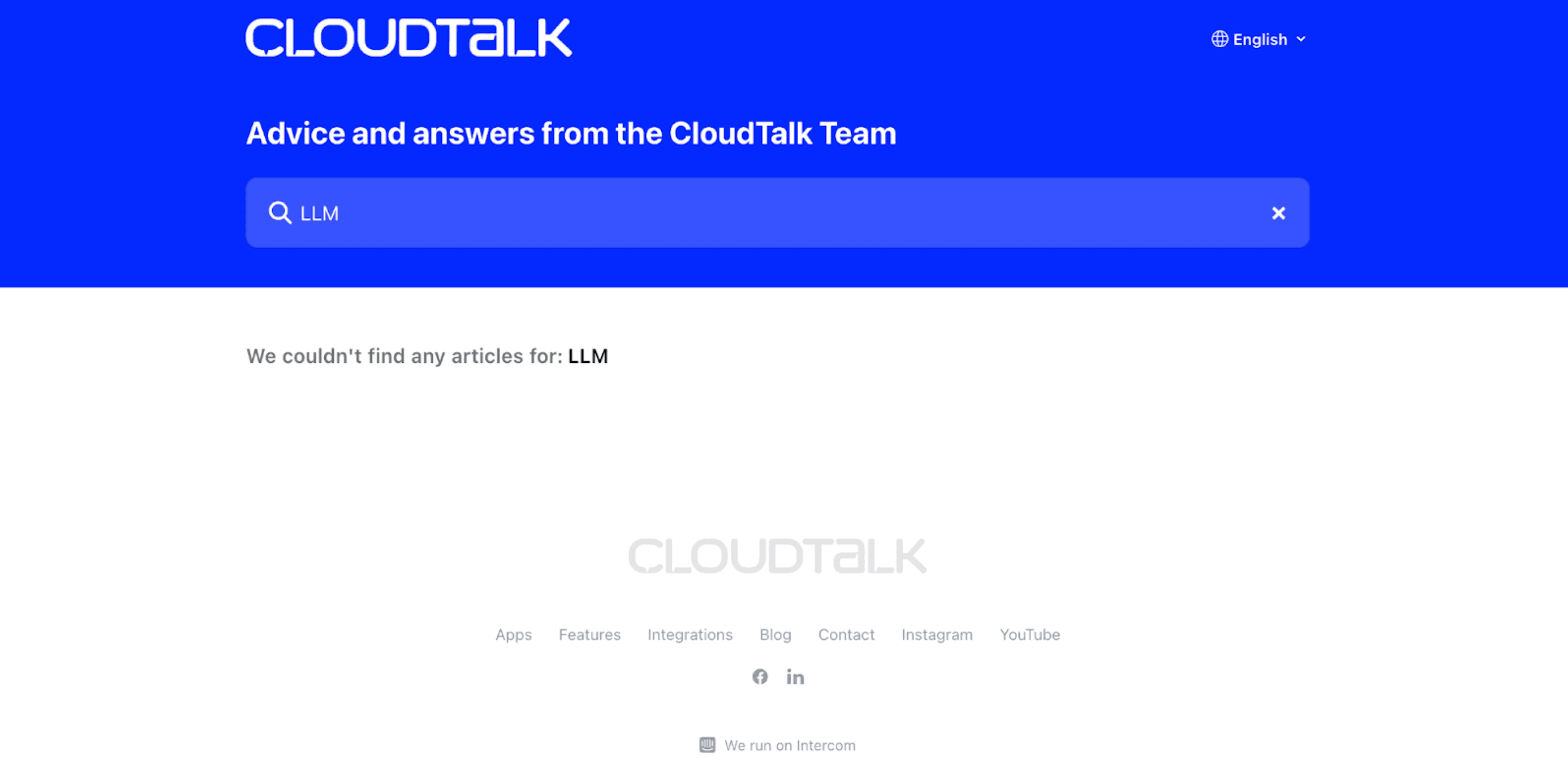
Source: https://www.help.cloudtalk.io/en/?q=LLM
A few of the features you get:
Click-to-call
Ai call transcription
Ai sentiment analysis
Pricing: Cloudtalk starts at $19 per user per month, with Ai features available as an add-on package ($9 per user per month).7
7. Freshdesk Contact Center
Freshdesk is part of the Freshworks telephony stable, and was formerly known as Freshcaller.
There's also another option on the Freshdesk website that's named slightly differently and lets users choose between “Support Desk” and “Omnichannel Contact Center” solutions. It's a bit confusing—which doesn't get you started on the right foot when it comes to ease of use—and this is something that users have brought up as well:

Source: G2
A few of the features you get:
Omnichannel dashboard
Chatbot builder and analytics
Ai Copilot and insights
Pricing:
Freshdesk’s pricing is a bit complex—the Freshdesk Growth plan starts at $15 per user per month, but gives you only the most basic ticketing features. For a decent suite of contact center features, you’d need the Freshcaller product, but has a free plan—but charges by the minute for calls.8
8. Twilio Flex
Twilio Flex is a cloud call center software that lets you tailor the solution to your own needs. Or rather, it lets your developers do it, since Twilio is a very tech-heavy developer-focused tool.
If you have the team to do it, Twilio can be a very powerful solution, which is why it's on the list, but because it requires such technical expertise, it's not very easy to use and is low on the list.
One unique thing to note is Twilio Flex’s API-based pricing model, which is a little different from other call center software, makes it quite scalable.
A few of the features you get:
Intelligent routing
Customizable workflows
Integrations and APIs
Reporting and dashboards
Pricing: You can choose to be charged per hour ($1 per active user hour) or pay a monthly flat rate of $150 per named user (agent, supervisor, administrator). There's a free trial that Twilio says gives you $5K worth of active user hours, although it doesn't include certain features such as insights or self-hosted UI.9
9. LiveAgent
LiveAgent is a call center software that comes with a helpdesk solution, which integrates different communication channels into one inbox. The main thing to remember here is if you need to provide phone support to customers, you’ll need to bolt on a separate VoIP service provider, which makes things more complicated.10
LiveAgent has a decent selection of Ai features, but lacks unified communications functionality so if you’re looking for a single solution to support all of your company’s external and internal communications, something like Dialpad Support would be a better fit.
A few of the features you get:
Ai answer assistant
Ai chatbot
Screen sharing
Ticket management
Pricing: Starts at $15 per agent per month10
10. Vonage Contact Center
Vonage is a pretty well-known communications solution with roots in residential telephony. Today, it has a business phone system product and also a contact center offering.
It's a decent low-cost option for small businesses that have relatively simple needs. Although it isn't as feature-rich as some of the other options on this list, it’s relatively easy to use, and if you want Ai features like speech analytics, you can pay extra for those as add-ons.11
A few of the features you get:
Screen pops
Call recordings
Speech analytics (add-on)
Virtual assistant (add-on)
Pricing: No pricing available on their website—you'll have to contact them to get a quote
11. GoTo Connect
You're probably more likely to have heard “GoTo Meeting” than “GoTo Connect,” but these are essentially a video and audio conferencing solution that's part of LogMeIn's suite of products.
Even though it's primarily known as a UCaaS solution that includes a mobile phone app, call forwarding, and an auto attendant—basically a cloud phone system that includes other communication channels—there is a “Connect Contact Center” plan that comes with Ai features like meeting summaries and speech analytics.12
A few of the features you get:
Voice, video, chat, SMS, social channels
Call analytics
Ai meeting summaries
Pricing: You’ll need to reach out to their sales team to get a quote for the GoTo Connect Contact Center plan.
12. Avaya AXP Public Cloud
Compared to the other cloud call center software on this list, Avaya has been around for a while, since the on-premises days, which puts it at a bit of a disadvantage when it comes to ease of use.
The AXP Public Cloud product has most of the Ai features you'd expect like conversational Ai, sentiment analysis, and self-service automations.
A few of the features you get:
Digital channels like email, web chat, text messaging
Self-service Ai tools
Visual workflow orchestration
Pricing: Pricing tiers are divided into Digital ($35 per user, per month), Voice ($60), All Media ($89), or Create Your Own (custom).13 Learn more about the best Avaya alternatives.)
Other key features to look for when choosing between contact center providers
From an ease of use perspective, Ai-powered insights and intuitive management tools can dramatically improve efficiency and customer experience. Here is some other functionality to consider:
Easy call routing
This is a must-have for any contact center software, so really, if the options you're looking at don't have an inbound call routing, they shouldn't even be on your list.
The thing to pay attention to here is how easy it is to set up and make changes to your call routing. If making a simple change requires a support ticket or IT help, it’s a productivity killer. Do you need to contact tech support or wait a few days (or weeks) for them to implement the changes?
Or can you just change your call routing options with a few clicks in your online dashboard—like in Dialpad Support?
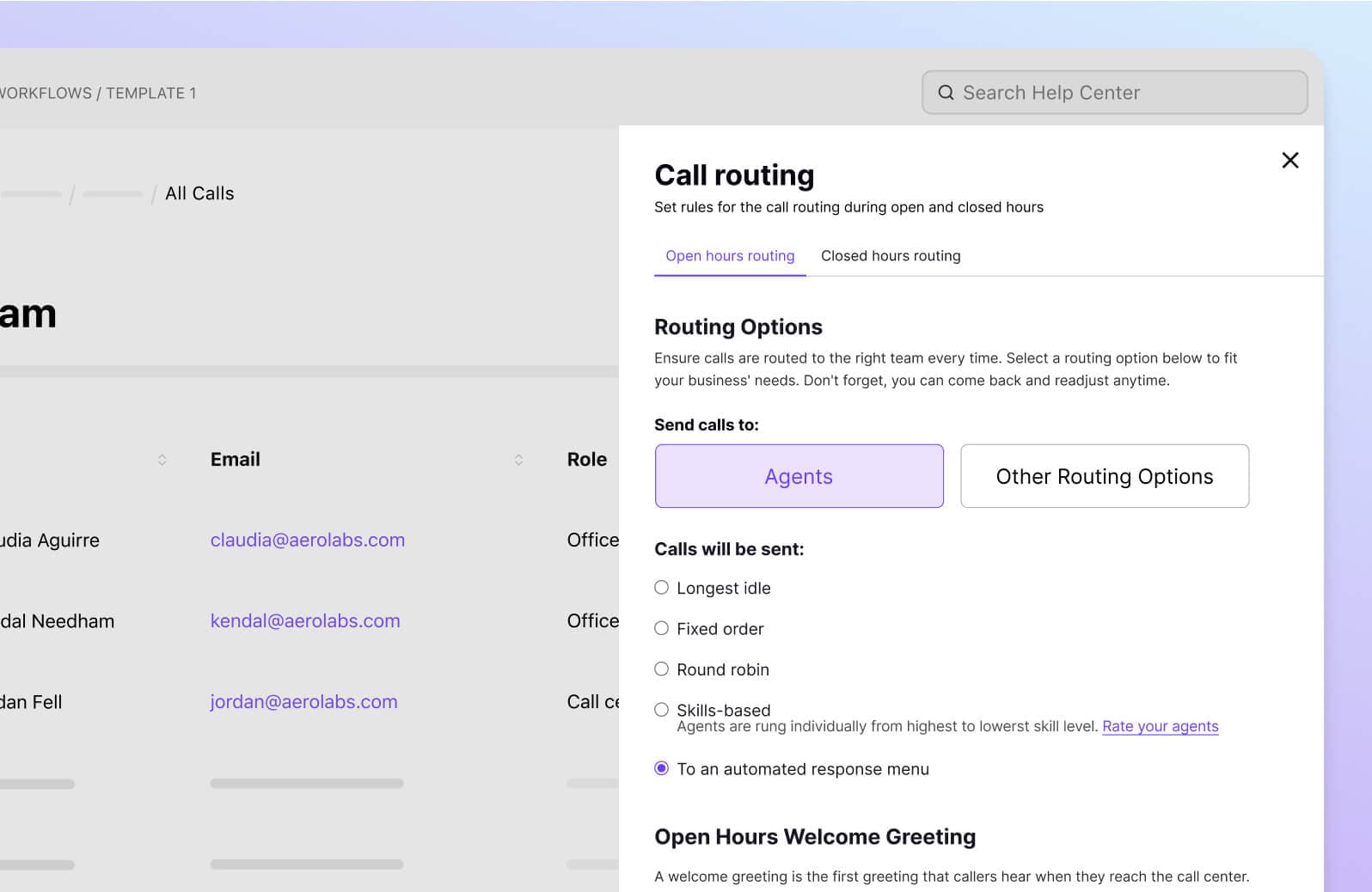
Unless you're at a company that lets years go by between making updates to your IVR (Interactive Voice Response) or ACD, this is an especially important feature to look for. It should be easy to streamline that call flow and let your callers self-service or route themselves to the right agent or department, without your team having to lift a finger.
Bottom line: Every contact center or call center software should have a routing feature. But the best call center software will make it easy for any contact center supervisor to do this, with no IT help.
"You just add a person's name and email, choose the phone number, and you're done," says Zak, President of Service Today.
Ai-driven speech analytics for more actionable insights
One of the biggest advantages of Ai in contact centers is that it unlocks real-time speech analytics for your supervisors and agents. It isn’t just about automation—this makes managing a contact center significantly easier. Dialpad Ai automatically transcribes calls and voicemails with industry-leading accuracy—providing instant visibility into customer conversations—but beyond transcription, Ai can also help:
Track key topics with automated keyword detection. Dialpad Ai can detect key topics (e.g., product complaints, competitor mentions) without supervisors manually listening to calls.
Coach agents in real time with Ai-driven assists that surface relevant information instantly. Instead of memorizing scripts, agents get real-time pop-ups with relevant information when needed—making training and onboarding much smoother.
Analyze sentiment and call trends to identify issues before they escalate.
These insights let supervisors spot coaching opportunities and make data-driven decisions faster.
Clear call quality
This one is often overlooked, but essential. In fact, a huge number of Dialpad's contact center customers switch to Dialpad—because of the better call quality.
Let's face it. You can't even get into “customer engagement strategies” or “customer satisfaction tactics” if you're dropping incoming calls left and right, or if your prospects can't hear your sales team's pitch because they keep cutting in and out.
And with some cloud contact center software, you can also easily add and remove users with a click, so that you're only paying for the licenses you need. (Yes, I'm talking about Dialpad.)
👉 Fun fact:
Dialpad's unique dual cloud architecture and global voice network are designed to give you excellent call quality, all over the world.
TL; DR - If your contact center team is heavily call-focused, then you'll need software that gives you HD-quality calls
Integrations with the tools you're already using
Agents work faster when their tools are connected. Whether it's a CRM (customer relationship management) tool or help desk software, your contact center software should have a decent range of integrations to streamline those workflows and minimize the need for agents and supervisors to constantly flip back and forth between different tabs or windows.
Dialpad, for instance, has a variety of CRM integrations with tools like Salesforce, HubSpot, Zoho CRM, and more. Not only do these integrations embed Dialpad's CTI dialer right inside those tools so that agents can click-to-dial directly from there, they also automatically log calls and activities:
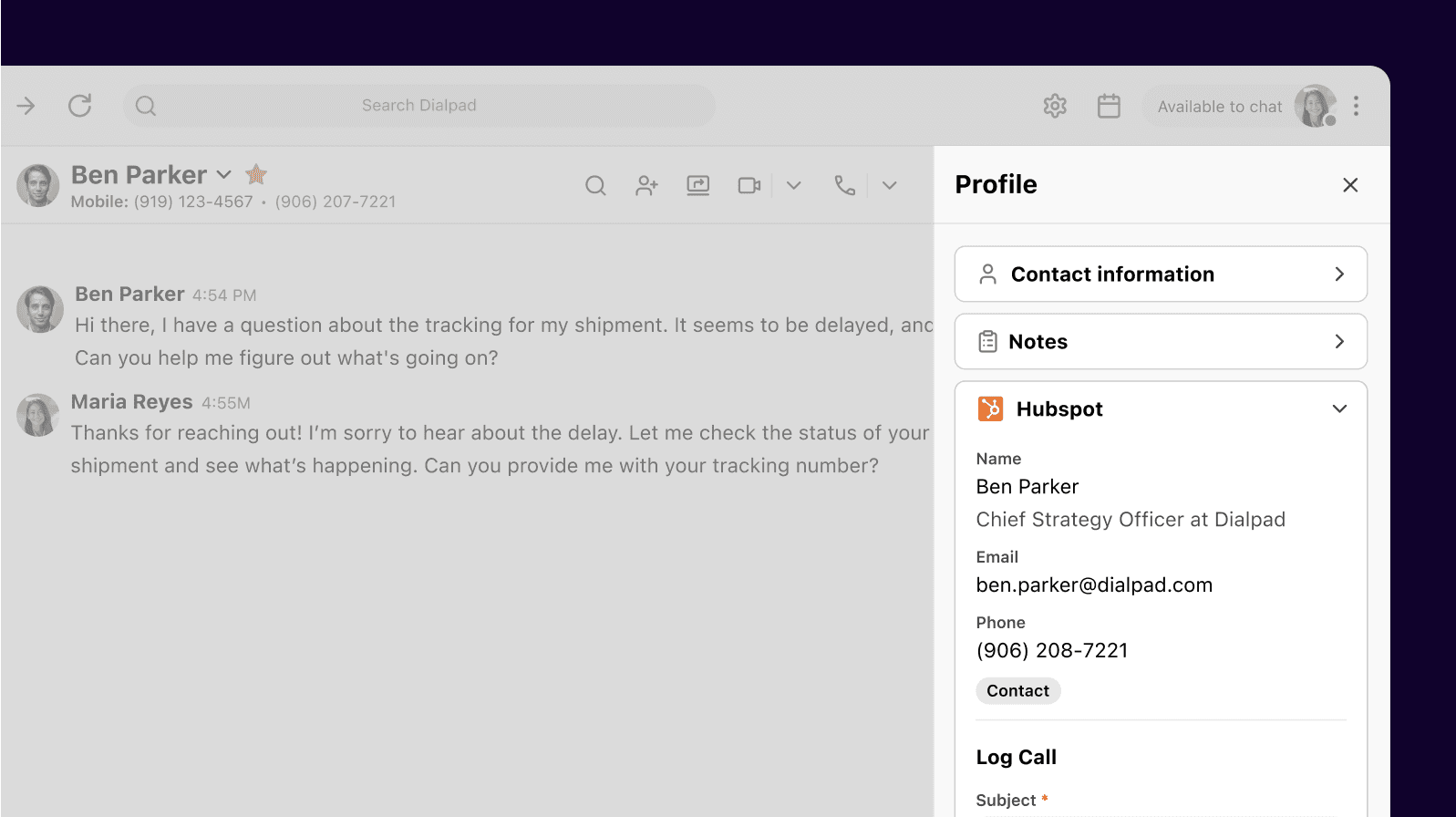
(And if you need an auto-dialer or power dialer, Dialpad's got that too.)
Real-time analytics and dashboards
Measuring the performance of your contact center in real time is, for most supervisors, a must-have, because if an issue comes up, you want to be able to address it in real time.
The thing to look for here is built-in, real-time analytics. Some contact center solutions don't have good embedded analytics and require you to contact their support team to get that data pulled (and some providers also charge you per support ticket submitted, so watch out for that). Sometimes, these requests can take hours, days, or if you're unlucky, weeks.
That's why having those metrics visible right inside an online dashboard is preferable—it streamlines that whole data gathering process for supervisors and leaders.
For example, Dialpad's contact center platform has built-in dashboards that show metrics like abandoned calls and missed calls, and also heat maps that show you call volume patterns and even average speed to answer:
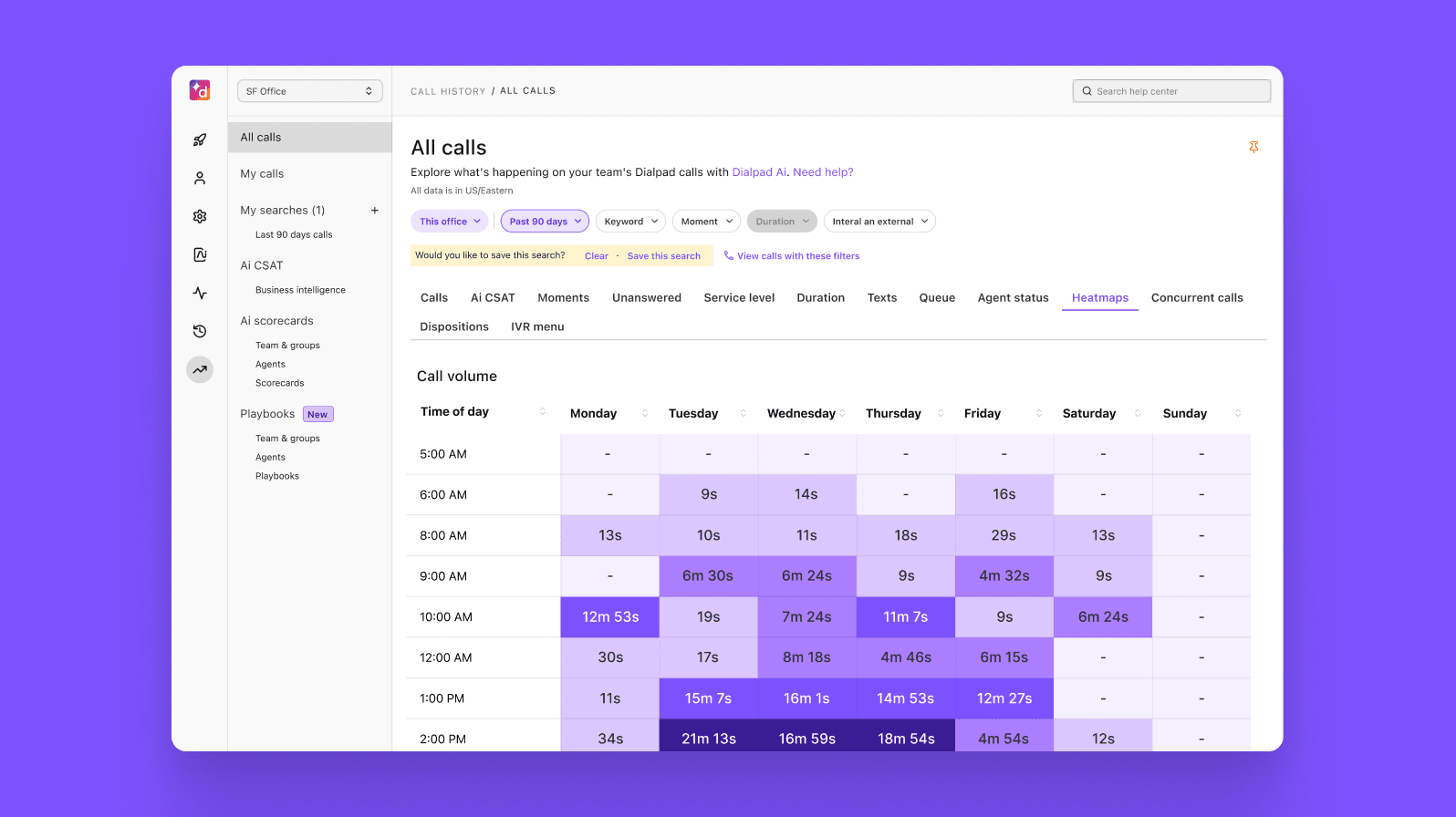
What people overlook: 3 details to pay attention to when shopping for a contact center solution
Is the solution truly integrated?
I don't mean just native integrations with the other CRMs or business software you're using (though those are important too)—this is referring to a truly integrated UCaaS and CCa solution.
Not every company might need or be aware of this, but if you do want to streamline your tech stack and not use five or six (or more) different tools when you only need one, then this is important.
Most companies today are using one tool for video conferencing, another for messaging, another separate phone app, and then another contact center platform.
Other companies, which are a little more ahead of the curve, will use one UCaaS solution (that handles all these phone calls, video conferencing, and messaging—but they'll still have a separate CCaaS solution.
It's actually possible to have software that integrates both the UCaaS side and CCaaS side into one. It's rare, but it's possible. Dialpad is one of the few that does this. (More on this below.)
👉 Look out for…
Providers that are actually reselling or whitelabelling other companies' software, but claim they unify both UCaas and CCaaS. This in itself isn't a “bad” thing, but what tends to happen with these kinds of Frankenstein-ed packages is that the end user will have to log into different accounts, you'll have two different user experiences, and you may not get customer support as easily for more complex questions because you'll have to be directed to the original provider whose software is being whitelabelled. Not a dealbreaker for everyone, of course, but something to be aware of.
Does it keep your business or organization compliant?
This is a pretty straightforward one. For businesses and organizations that are in regulated industries like healthcare or financial services, your contact center platform needs to help you stay compliant with HIPAA, GDPR, and so on.
(See how organizations in those industries are using Dialpad Support as their contact center platforms: Fenway Health and Camino Financial.)
We've seen many customers switch over to Dialpad Support because they thought that another provider would help them maintain HIPAA compliance, but it didn't. Make sure your shortlist checks those boxes.
Provide a better customer experience with an easy-to-use cloud-based contact center solution
If you want a fully customizable contact center solution, or have the IT resources to support it, there are definitely options that give you that 100% control, like Twilio Flex.
If you want a fully on-premises solution, there are PBX-focused solutions for that too, like Avaya.
But if you just want something that's easy to use and quick to set up, you should at least check out Dialpad Support. It's easy to admin from anywhere, integrates with a range of different tools to give you full WFM/QM functionality, and also has 24/7 customer support—without charging extra.
Whether you want to better understand and manage your customer interactions or close more deals, Dialpad Support can help with that!
1five9.com/products/pricing
2aircall.io/pricing/
3aircall.io/blog/tech-team-stories/building-knowledge-agents/
4gartner.com/reviews/market/contact-center-as-a-service/vendor/talkdesk/product/talkdesk/review/view/5779758
5talkdesk.com/pricing/
6ujet.cx/pricing
7cloudtalk.io/pricing/
8freshworks.com/freshdesk/pricing/
9twilio.com/flex#pricing
10liveagent.com/pricing/
11vonage.com/contact-centers/plans/
12goto.com/pricing/connect
13avaya.com/en/products/experience-platform/public/pricing/
Need contact center software?
Book a demo to see how easy it can be to set up and use Dialpad's contact center solution, or take a self-guided interactive tour of the app first!

